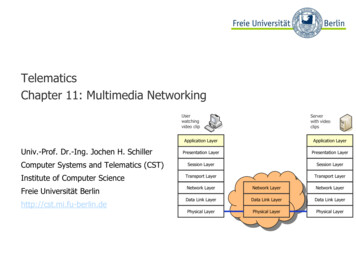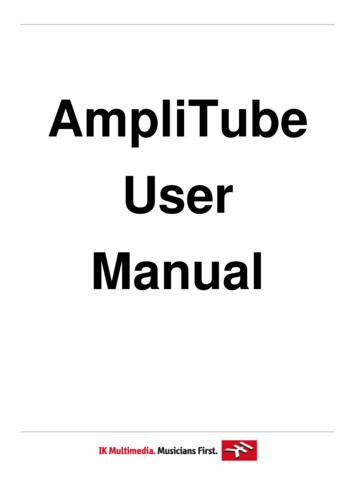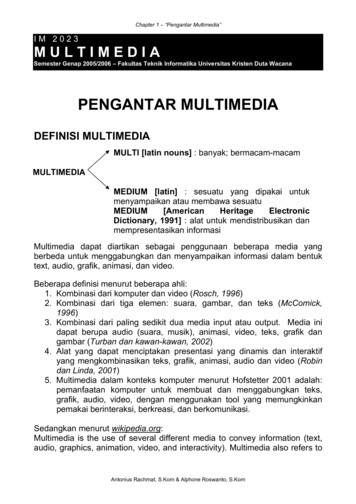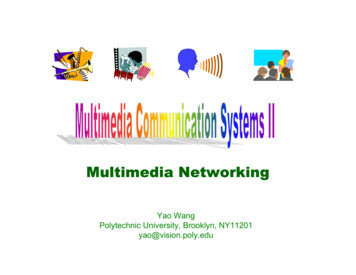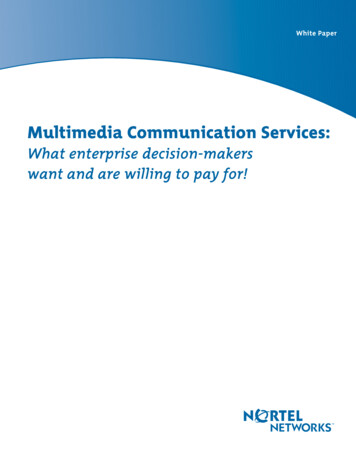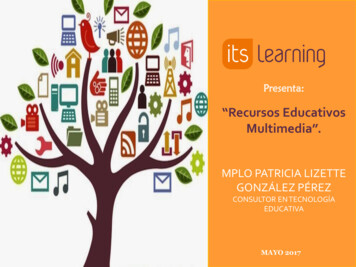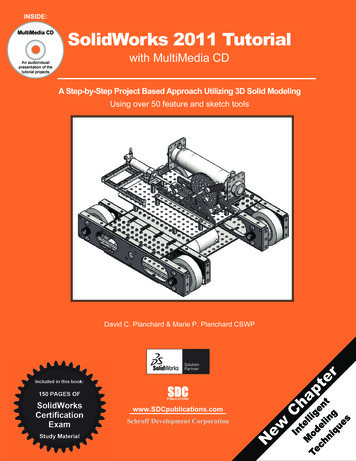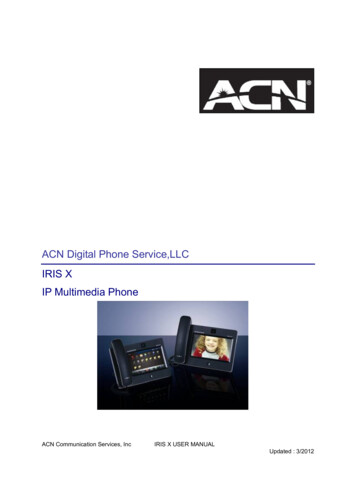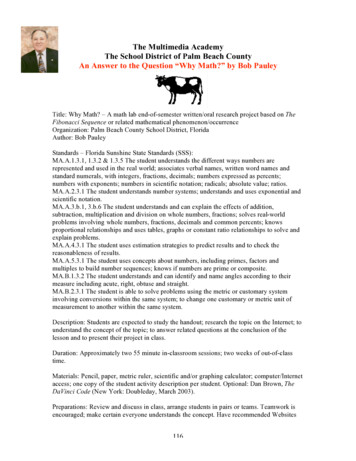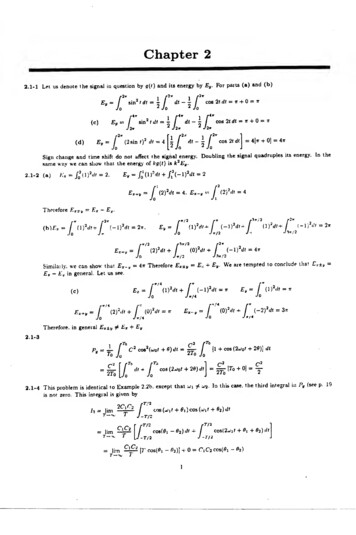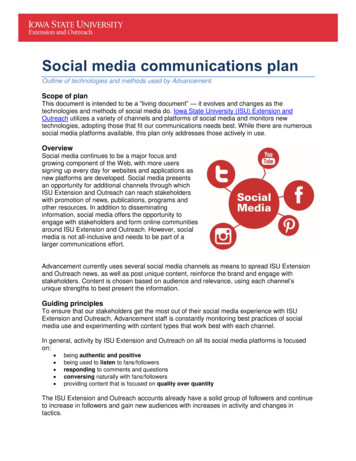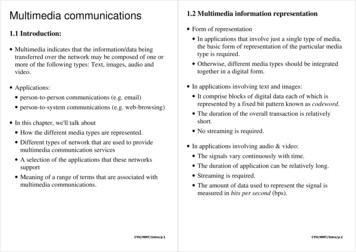
Transcription
Multimedia communications1.1 Introduction: Multimedia indicates that the information/data beingtransferred over the network may be composed of one ormore of the following types: Text, images, audio andvideo. Applications: person-to-person communications (e.g. email) person-to-system communications (e.g. web-browsing) In this chapter, we'll talk about How the different media types are represented. Different types of network that are used to providemultimedia communication services A selection of the applications that these networkssupport Meaning of a range of terms that are associated withmultimedia communications.& 007 ,QWUR S 1.2 Multimedia information representation Form of representation In applications that involve just a single type of media,the basic form of representation of the particular mediatype is required. Otherwise, different media types should be integratedtogether in a digital form. In applications involving text and images: It comprise blocks of digital data each of which isrepresented by a fixed bit pattern known as codeword. The duration of the overall transaction is relativelyshort. No streaming is required. In applications involving audio & video: The signals vary continuously with time. The duration of application can be relatively long. Streaming is required. The amount of data used to represent the signal ismeasured in bits per second (bps).& 007 ,QWUR S
Compression is generally applied to digitized signals toreduce (i) the resulting bit rate to a level a network cansupport and (ii) the time delay between a request beingmade for some information and the informationbecoming available.1.3.1 telephone networks Designed to provide a basic switched telephone service. 'Switched' means that a subscriber can make a call to anyother telephone that is connected to the total network.1.3 Multimedia networks There are 5 types of communication network that areused to provide multimedia communication services: Telephone networks Data networks Broadcast television networks Integrated services digital networks (ISDN) Broadband multuiservice networks Characteristics: The first 3 types were initially designed to provide justa single type of service. The last 2 types were designed to provide multipleservices.& 007 ,QWUR S & 007 ,QWUR S
1.3.2 data networks It's designed to provide basic data communicationservices such as email and general file transfer. Two most widely deployed networks of this type are theX.25 network and the Internet. The X.25 network is restricted to relatively low bit ratedata applications only. The Internet is made up of a vast collection ofinterconnected networks all of which operate using thesame set of communication protocols. Telephone networks operate in circuit mode. For each call, a separate circuit is set up through thenetwork for the duration of the call. The access circuits that link the telephone handsets to aPSTN or PBX were designed to carry the 2-way analogsignals associated with a call. Communication protocol is an agreed set of rules that are adhered to by allcommunication parties for the exchange ofinformation. defines (i) the sequence of messages for the exchangeof information and (ii) the syntax of these messages. A user may access to the Internet through anintermediate Internet service provider (ISP) network. Though modern PSTNs operate in a digital mode, amodem is used to carry a digital signal over the analogaccess circuits.& 007 ,QWUR S & 007 ,QWUR S
A network is called intranet if all internal services areprovided using the same set of communication protocols. Different types of network are connected to the Internetbackbone network through an internetworking unitcalled a gateway. A gateway is also known as a router as it is responsiblefor routing and relaying all messages to and from theconnected networks. All data networks operate in packet mode. A packet is a container for a block of data and theinformation for routing the packet to the destinationthrough the network. This mode is used because the format of the dataassociated with data applications is normally in the formof discrete blocks of text or binary data with varyingtime intervals between each block.& 007 ,QWUR S & 007 ,QWUR S
1.3.3 Broadcast television networks designed to support the diffusion of analog television(and radio) programs throughout wide geographicalareas. Broadcast media include Cable distribution network : for a town or city Satellite network : for larger areas Terrestrial broadcast network : for larger areas The traffic is 1-way or asymmetric. It generally works with a low bit rate return channeloffered by a cable network for interaction purposes toprovide a range of additional services such as homeshopping and games playing. The subscriber accesses the cable distribution networkthrough a set-top box.& 007 ,QWUR S & 007 ,QWUR S
1.3.4 Integrated services digital networks Designed to provide PSTN users with the capability ofhaving additional services. This was achieved by(i) converting the access circuits that connect userequipment to the network into an all-digital form,and(ii) providing 2 separate communication channels overthese circuits. This all-digital access circuit is known as a digitalsubscriber line (DSL) The digitization of a toll-quality analog speech producesa constant bit rate bitstream of 64kbps. (64kbps is henceused as a basic unit.) Options of service: Basic rate access(BRA) : supports 2 independent64kbps channels or 1 128kbps channel (with anaggregation unit to synchronize 2 64kbps channels) Primary rate access (PRA) : supports 1 1.5/2.0Mbpschannel It can also support a single switched channel ofpx64kbps, where p 1,2.30.& 007 ,QWUR S 1.3.5 Broadband multiservice networks Designed in mid-80s for use as public switched networksto support a wide range of multimedia communicationapplications. "Broadband" means it can support a bit rate higher thanthat an ISDN can support ( 2Mbps). This type of network is also known as broadband ISDN(B-ISDN) while ISDN is known as narrowband ISDN(N-ISDN). Switching and transmission methods that are used inthese networks must be more flexible as they aredesigned to support multiple services.& 007 ,QWUR S
All media types are converted into digital form andintegrated together, and the resulting stream is dividedinto fixed-sized packets known as cells.1.4 Multimedia applicationCategoryMediaApplication descriptions Switching fixed-sized cells can be carried out muchfaster than switching variable-length , voice-mail,teleconferencing Different multimedia applications generate cell streamsof different rates and hence the rate of transfer of cellsthrough the network varies. This mode of transmission isknown as asynchronous transfer mode (ATM).ImageFacsimileTextElectronic mailText and imagesComputer-supportedcooperative working This type of network is also known as ATM network orcell-switching network.Speech and videoVideo telephoney, video mail,videoconferencingText, image, audio Multimedia electronic mail,and videomultiparty video games etc.InteractiveText, image, audio Information retrievaal (news,applications over and videoweather, books, magazines,the Internetvideo games, product literatureetc.)Electronic commerceEntertainmentservicesText, image, audio Audio/CD-on-demandand videoMovie/video-on-demandAnalog and digital televisionbroadcastsInteractive television& 007 ,QWUR S & 007 ,QWUR S
1.5 Application and network terminology1.5.1 Media types The information flow associated with the differentapplications can be either continuous or block mode. In the case of continuous media: Mode of operation : streaming The information stream is generated by the sourcecontinuously in a timely-dependent way and playedout directly as it is received at the destination. e.g. audio, video The continuous media is called real-time media as it'sgenerated in a time-dependent way. The source stream can be generated at a constant bitrate (CBR) or a variable bit rate (VBR). We review some of the terminology used in relation to thedifferent media types and the terminology and operational characteristics of thedifferent type of communication channels provided bydifferent networks.& 007 ,QWUR S In the case of block-mode media: Mode of operation: downloading The source information comprises a single block ofinformation that is created in a time-independent way. E.g. text, image The delay between the request being made and thecontents of the block being outputted at the destinationis called round-trip delay. (should be few seconds)& 007 ,QWUR S
1.5.2 communication modes1.5.3 Network types The transfer of the information streams associated withan application can be 1 of the 5 modes: Simplex:1 direction only Half-duplex: flows in both directions but alternately Full-duplex: flows in both directions simultaneously(1-to-1 transmission) Broadcast: 1-to-all transmission Multicast:1-to-many transmission There are 2 types of communications channel associatedwith the various network types: circuit-mode & packetmode. Channels in circuit-mode: Operates in a time-dependent way Also known as a synchronous communicationschannel since it provides a constant bit rate service. Channels in packet-mode: Operates in a time-varying way Also known as an asynchronous communicationschannel since it provides a variable bit rate service.Circuit-mode: In duplex communications, if the flows in the 2directions are equal, the information flow is symmetric.Otherwise, it's asymmetric.& 007 ,QWUR S This type of network is also known as a circuitswitched network. A circuit-mode network comprises an interconnectedset of switching offices/exchanges to which thesubscribers/computers are connected. Prior to sending any information, the source must firstset up a connection through the network. The bit rate associated with the connection is fixed. The messages associated with the setting up andclearing of a connection are known as signalingmessages. There is a call/connection setup delay.& 007 ,QWUR S
Examples: PSTN and ISDNPacket-mode: There are 2 types of packet-mode networks:connection-oriented (CO) and connectionless (CL) This type of network is also known as a packetswitched network. A connection-oriented network: A connection-oriented network comprises aninterconnected set of packet-switching exchanges(PSEs). Prior to sending any information, a connection isfirst set up through the network. The connection utilizes only a variable portion of thebandwidth of each link and hence it's known as avirtual connection or a virtual circuit (VC).& 007 ,QWUR S & 007 ,QWUR S
A call request packet contains: source/destination addresses virtual circuit identifier(VCI)- used for setting up a VC Example: Internettimecall request packetsourceterminal/computercall accepted packetdestinactionterminal/computerA VC isavailablecall clear packetHow to set up a VC Each PSE has a routing table which defines a packetcoming from which input link will be delivered towhich output link. Examples: X.25, ATM network Connectionless network: The establishment of a connection is not requiredand the two communicating terminals/computers cancommunicate and exchange information as and whenthey wish. Each packet must carry the full source anddestination addresses in its header in order for eachPSE to route the packet onto the appropriateoutgoing link. The term router is normally used rather than PSE.& 007 ,QWUR S Basic mode of operation (Common to PS networks): When a packet is forwarded to a PSE/router, it's storedin a buffer, checked, discarded if there is any problem(due to congestion or error), or else forwarded to nextPSE/router if the outgoing link is available. Each PSE/router has a routing table and it's used todetermine the outgoing link to which a packet from aparticular incoming link should forward.& 007 ,QWUR S
This mode of operation is called store-and-forward asa packet has to wait in a PSE/router until the outgoinglink is available. The service offered by a packet-switched network is saidto be a best-effort service as the transmission of a packetis not guaranteed to be successful. Mean packet transfer delay: The mean of overall transferdelay of a packet across the network Delay variation or jitter : the variation about the meanpacket transfer delay& 007 ,QWUR S 1.5.4 Multipoint conferencing It's implemented in one of the 2 ways: centralized anddecentralized. The centralized mode is used with circuit-switchednetworks such as a PSTN or an ISDN. The decentralized mode is used with packet-switchednetworks which support multicast communications. (e.g.LAN, intranet and the Internet) A third mode known as the hybrid mode can be used.& 007 ,QWUR S
1.5.5 Network QoS the network Quality of Service (QoS) parameters are the operational parameters associated with acommunications channel through a network, and collectively determine the suitability of the channel inrelation to its use for a particular application. Circuit-switched network: (CBR network) The QoS associated with a CBR channel that is set upthrough a circuit-switched network include: The bit rate The mean bit error rate The transmission delay The mean bit error rate (BER) of a channel is theprobability of a bit being corrupted during itstransmission across the channel in a defined timeinterval.& 007 ,QWUR S & 007 ,QWUR S
Issue of the block size: In practice, most networks provide an unreliableservice (best-effort service). Information is partitioned into blocks during itstransmission so as to minimize the propagation oferror. Any blocks containing bit errors will be discarded. A reliable service can be offered by using errordetec
Different types of network that are used to provide multimedia communication services A selection of the applications that these networks support Meaning of a range of terms that are associated with multimedia communications. & 007 ,QWUR S 1.2 Multimedia information representation Form of representation In applications that involve just a single type of media, the
